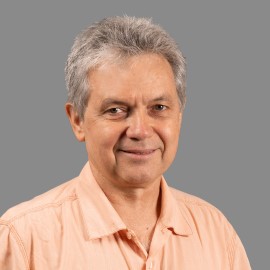
Mykhaylo V. Ruchko, Ph.D.
Biography
Dr. Mykhaylo Ruchko, Assistant Professor, received his Master of Science in Biochemistry from the Taras Shevchenko Kyiv State University, Kyiv, Ukraine, his Ph.D. in Biochemistry from Palladin Institute of Biochemistry, Ukrainian Academy of Sciences, Kyiv, Ukraine, and completed his postdoctoral fellowship in Pharmacology at the Frederick P. Whiddon College of Medicine.
Research
Free radicals generated by different exogenous and endogenous sources occupy an amazingly central role in a wide variety of biological processes. Reactive oxygen species (ROS) are known to play a dual role in biological systems, since they can be either harmful or beneficial to living organisms. Oxygen-mediated damage to cell structures, including lipids and membranes, proteins and nucleic acids, is well recognized, but a growing amount of evidence shows that ROS also act as second messengers in intracellular signaling cascades. My research interest concentrates on both - damaging and signaling - sides of free radical's action in cells. Current topics include:
- Oxidative stress and its influence on genome stability.
- Mitochondrial DNA as a sentinel molecule, severity and persistence of damage to which determines the cell viability.
- Oxidative mitochondrial DNA damage and its role in initiation of endothelial cell apoptosis caused by oxidative stress.
- Role of controlled ROS-mediated oxidative DNA damage and repair in normal transcriptional regulation.
- Effective biomarkers of oxidative stress.
Publications
Yuzefovych LV, Pastukh VM, Ruchko MV, Simmons JD, Richards WO, Rachek LI. Plasma mitochondrial DNA is elevated in obese type 2 diabetes mellitus patients and correlates positively with insulin resistance. PLoS One. 2019 Oct 10;14(10):e0222278. doi: 10.1371/journal.pone.0222278. PMID: 31600210; PMCID: PMC6786592.
Bradley JM, Li Z, Organ CL, Polhemus DJ, Otsuka H, Islam KN, Bhushan S, Gorodnya OM, Ruchko MV, Gillespie MN, Wilson GL, Lefer DJ. A novel mtDNA repair fusion protein attenuates maladaptive remodeling and preserves cardiac function in heart failure. Am J Physiol Heart Circ Physiol. 2018 Feb 1;314(2):H311-H321. doi: 10.1152/ajpheart.00515.2017. Epub 2017 Nov 3. PMID: 29101177; PMCID: PMC5867654.
Black GE, Sokol KK, Moe DM, Simmons JD, Muscat D, Pastukh V, Capley G, Gorodnya O, Ruchko M, Roth MB, Gillespie M, Martin MJ. Impact of a novel phosphoinositol-3 kinase inhibitor in preventing mitochondrial DNA damage and damage-associated molecular pattern accumulation: Results from the Biochronicity Project. J Trauma Acute Care Surg. 2017 Oct;83(4):683-689. doi: 10.1097/TA.0000000000001593. PMID: 28930961; PMCID: PMC5938741.
Lee YL, Obiako B, Gorodnya OM, Ruchko MV, Kuck JL, Pastukh VM, Wilson GL, Simmons JD, Gillespie MN. Mitochondrial DNA Damage Initiates Acute Lung Injury and Multi-Organ System Failure Evoked in Rats by Intra-Tracheal Pseudomonas Aeruginosa. Shock. 2017 Jul;48(1):54-60. doi: 10.1097/SHK.0000000000000838. PMID: 28125528; PMCID: PMC5468468.
Pastukh VM, Gorodnya OM, Gillespie MN, Ruchko MV. Regulation of mitochondrial genome replication by hypoxia: The role of DNA oxidation in D-loop region. Free Radic Biol Med. 2016 Jul;96:78-88. doi: 10.1016/j.freeradbiomed.2016.04.011. Epub 2016 Apr 25. PMID: 27091693; PMCID: PMC4912408.


